"And Saint Wilfred's bone of Ripon to keep cattle from pain,
And his needle which sinners can not pass the eye"
(Holme, 1537)
Ripon cathedral is built on the site of an early church established by
saint Wilfrid in 672 AD. The small crypt beneath the cathedral is believed to
be part of this church, and archaeological survey work revealed that the crypt
was built with reused Roman stonework, probably brought from Aldborough, 6
miles to the south east. Within the crypt, a set of rough stone steps can be
seen leading up to a small opening through the north wall. This opening is
known as Saint Wilfrid's Needle, and for hundreds of years it was the focus of
unusual religious and folklore practices.
The "Neddel of Seynt
Wilfred" is mentioned in a will dating from 1466, but it was William Camden's
Britannia which first provided some curious details about the 'Needle's
Eye' ...
"Within the Church, Saint Wilfrides Needle was in our grandfathers
remembrance very famous. A narrow hole this was, in the Crowdes or close
vaulted roome under the ground, whereby womens honestie was tried. For such
as were chast did easily passe through, but as many as had played false were
miraculously, I know not how, held fast and could not creepe through."
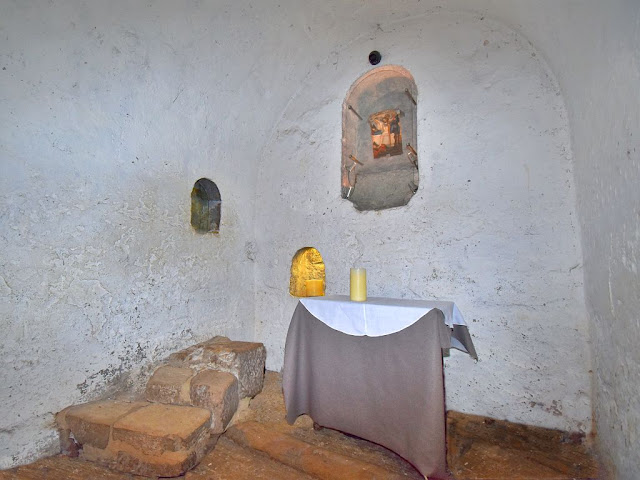
|
|
The crypt with stone steps below Saint Wilfrid's Needle |
It is hard to imagine many women willingly submitting to this type of test, but this was a time when females were regarded as the property of their husband or father. The Britannia reference notes that being able to pass through the Needles Eye was a test of living a chaste life - either as a virgin or without adultery. However, the size of the opening would obviously favour slim or smaller women, making the test rather flawed. This would seem to cast doubt on the information given to Camden, unless the story of women being treated this way by the church had another purpose.

|
|
The 'Needle's Eye' (now blocked with a glass panel to stop people
climbing through) |
Camden compiled his Britannia during the years of religious and
political turmoil which followed the Reformation, so the 'grandfathers
remembrance' is a reference to the old days of the Catholic church, which was
then seen as discredited and corrupt. To the 'new' Protestant faith, Saint
Wilfrid's Needle was another example of the 'papist superstitions' that needed
to be rooted out, and this is highlighted by a church commission ruling in
1567. This court ordered Thomas Blackburne (the parish priest at Ripon) to
...
"cause the place called Saincte Wilfrides Nedle to be stopped up and an
Altar standinge in a lyttle chapel in the vault where the same nedell is to
be taken down and defaced."
He was also ordered to do penance from the pulpit, and to confess that
he was "a most blinde guide of an olde and superstitious custome" and
for his religious duties involving Saint Wilfred's needle
"where of old tyme idolytory and damnable supersticious whorshippings have
been usually frequented to the peril and danger not only of myne owne sowle
but of those i have misled i am nowe hartilie sorry"
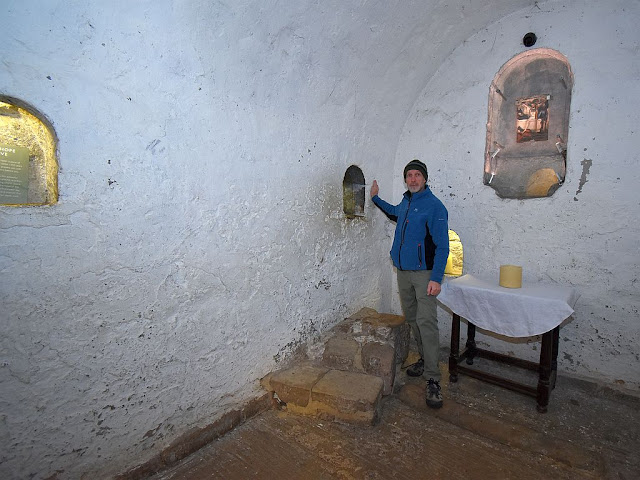
|
|
A penitent sinner for scale |
It has been pointed out that the 'Needle's Eye' was originally just an alcove in the wall, like the others in the crypt. At some point during the Medieval period the back of the alcove was knocked out, making a hole through into the passage way behind it. This may have been done intentionally to create a 'religious feature', or it may have had a more practical purpose. In those days, the subterranean crypt and side passages would be in total darkness except for candles or oil lamps, so it is possible that the hole was made to provide some ventilation through the crypt. If a group of people spent any length of time saying prayers or chanting with candles burning etc. it is likely that there would be issues with fumes or stale air inside the crypt.
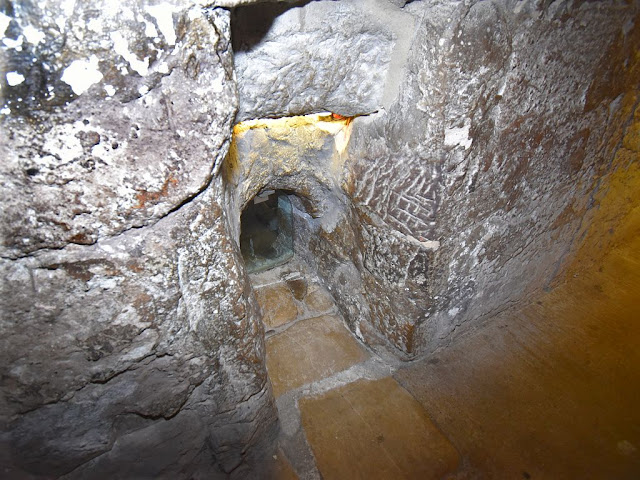
|
|
Saint Wilfrid's Needle from the passage side |
What ever the reason for making the hole, it did become a
religious feature, and was regarded as having 'miraculous' power. The crypt
itself was a site of pilgrimage, housing holy relics and saints bones, which
were also believed to be a source of miracles. So this was a potent spiritual
location, and it is quite possible that the"olde and superstitious custome"
connected with Saint Wilfrid's Needle started with the pilgrims who visited
the crypt.
One reference notes the belief that the 'Needle's Eye' was so narrow that only Christ could pass through it, and this idea echoes the bible story where Jesus says "it is easier for a camel to pass through the eye of a needle than for a rich man to enter the kingdom of God". The 16th century reference by Wilfred Holme of York, notes that "sinners" could not pass through Saint Wilfrid's Needle, and elsewhere it is mentioned that any one accused of wrong doing could prove their innocence by being able to pass through the opening. This begins to sound like Saint Wilfrid's Needle was more than just a test of chastity, and was actually an example of the medieval 'trial by ordeal'. The opening through the wall is not actually that narrow, measuring 33cm wide by 45cm high, so most people could probably squeeze through it. The effectiveness of the trial would rely on the fear that the miraculous power of the crypt would hold fast a guilty person (perhaps to prevent them from entering the holy of holies?).
That the old church supported the activities connected with Saint Wilfrid's needle is shown by the stone steps placed below the opening. These steps are not an original feature of the crypt, and were roughly built to provide easier access to the opening through the wall. The steps were probably in place before the Reformation, as it is highly unlikely they would be added afterwards, and be of such rough workmanship. What is also noticeable is how worn the steps are, which points to many hundreds of people having used them (this wear is also visible around the passage side of the opening). Was all this wear just from women forced to undergo a test of their chastity?
It is unclear which direction people passed through the hole, but either way it is likely that they would need assistance, and this would explain why the priest was chastised for being a guide to the custom. Later accounts describe people standing on the steps within the crypt and going head first through the opening, while being pulled from the other side. With people being 'delivered' out of the holy crypt in this way it is hard not to see an element of birth (or rebirth) symbolism, and this might hint at the miraculous power of the Needle's Eye having extended beyond just the trial by ordeal.

|
| The Tolvan Stone near Gweek in Cornwall. |
In the world outside the church there are records of folklore practices connected with crawling through holes or gaps in rocks - for healing, fertility, and marriage purposes. These activities were usually undertaken by women, who would pass their children through holes in rocks in the hope of curing illness. Women would also squeeze through holes or rock clefts in the hope of securing a good marriage, an easy childbirth, or to cure infertility. Camden's Britannia does associate St Wilfrid's Needle with women's sexual status and activity, and noted that the Needle's Eye could miraculously affect those who passed through it. Given the folklore connected with passing through hole in rocks it is likely that at least some women came to St Wilfrid's Needle with these folklore beliefs in mind. Perhaps praying at the altar in the crypt before 'Threading the Needle'.
After the reformation, the crypt seems to have been sealed up and used as a burial vault for a 100 years or more. It was re-opened in the mid 1700's, and visitors came to explore the crypt by candlelight - curious to see the location of the chastity test made famous by Camden's Britannia. Although religious practices had changed during the intervening years, the tradition connected with the Needle's Eye seems to have lingered on. It came to be regarded as a 'lucky hole' - bringing good fortune to those who passed through it. Women now squeezed through the opening voluntarily, in the belief that they would then be married within the year. This seems to have continued until at least the early 1900's and probably later, as while visiting the crypt in 2022, another visitor mentioned that her friend had crawled through the opening when she was at college in Ripon in the 1980's. So the tradition has carried on in one form or another for hundreds of years, however today, Saint Wilfrid's Needle is blocked by a glass panel to prevent people climbing through. In a way this is understandable, but perhaps they could have a Needle's Eye 'open day' to keep the tradition alive.
After notes
It is interesting to note that a number of writers refer to the opening
in the crypt as Saint Winifred's Needle (rather than Wilfrid's). Writing in
the late 1600's, the Leeds historian Ralph Thoresby refers to it as St
Winifred's, as does Daniel Defoe, writing around the same time. Both men would
be aware of the minster's dedication to Saint Wilfrid, so it unlikely they
made a mistake. Along with other references this suggests that at various
times both saints have been connected with the Needle's Eye.
Saint winfride was a Welsh female saint who became a virgin martyr when
she rejected the advances of a welsh prince, who then cut off her head.
Winfride wanted to follow a chaste life in the service of God, so perhaps she
became linked with the Needles' Eye at Ripon after Camden noted its use as a
test of chastity.
It is also worth noting the reference to another Saint
Winifride's Needle on the summit of Roseberry Topping, where people crawled
through a cleft in the rock near a hermitage. Why they did this is not
recorded but as it was a religious site the beliefs may have been similar to
those at Ripon.
Reference
Camden, W. (1586) Britannia
Holme, W. (1572) The Fall and
Evil Success of Rebellion (written in 1537)

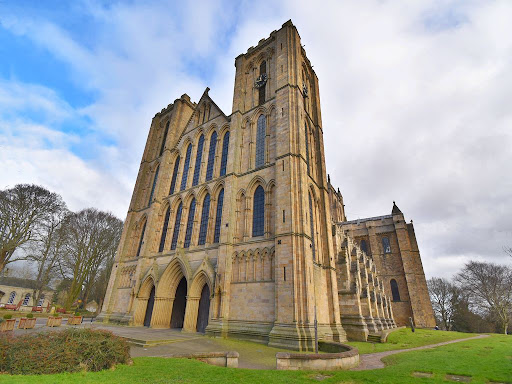
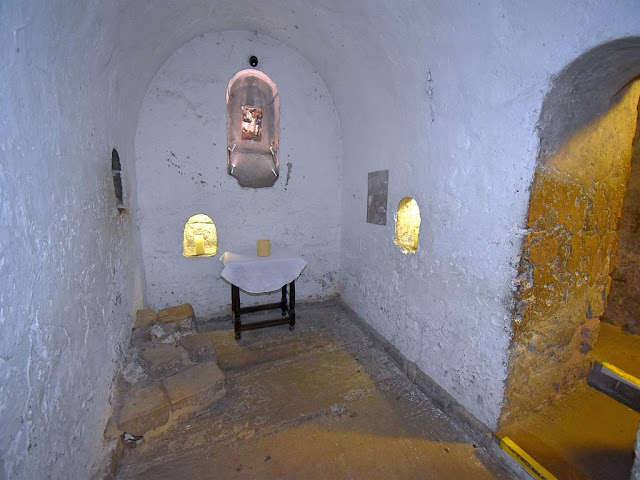
Post a Comment